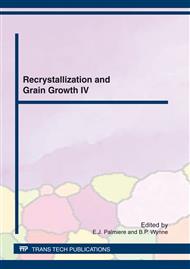p.629
p.635
p.643
p.649
p.655
p.661
p.667
p.673
p.679
On the Effect of Strain Reversal on Static Recrystallisation and Strain-Induced Precipitation Process Kinetics in Microalloyed Steels
Abstract:
Recent observations show that the strain reversal affects significantly and in a complex way both the static recrystallisation (SRX) and strain-induced precipitation (PPT) kinetics in Nb-microalloyed steel. It is already known that the recrystallisation stagnation is a consequence of the competition between the driving pressure for recrystallisation and the pinning pressure caused by the strain-induced precipitation of Nb (C,N) precipitates. Both of these parameters depend in turn on the local dislocation density. Thus, it is expected that a variation of the local dislocation density due to reversal of the strain will affect at the same time the local driving and the pinning pressures, which will cause the difference in the hardening levels. In the present paper, the influence of strain path change on microstructure evolution and mechanical behaviour in Nb-microalloyed steel (API X-70 grade) was studied. The deformation schedules were designed in order to investigate an effect of strain reversal on both static recrystallisation and strain-induced precipitation process kinetics. Flow curves recorded during deformation of X-70 steel showed clear influence of applied strain path on both static recrystallisation kinetics and strain-induced precipitation process.
Info:
Periodical:
Pages:
655-660
Citation:
Online since:
April 2012
Authors:
Price:
Сopyright:
© 2012 Trans Tech Publications Ltd. All Rights Reserved
Share:
Citation:


